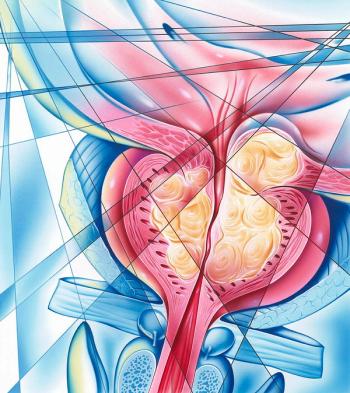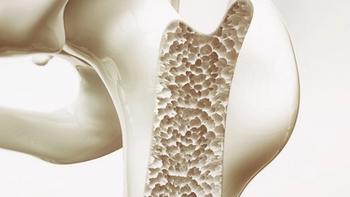
Oncology NEWS International
- Oncology NEWS International Vol 6 No 11
- Volume 6
- Issue 11
Neoadjuvant Androgen Deprivation Before Prostatectomy in T1-T3 Patients
Androgen deprivation has been used prior to radical prostatectomy in an attempt to improve local control of prostate cancer and delay time to cancer progression. Thirty men (mean age of 65) with clinical stage T3 adenocarcinoma of the prostate were entered into a phase II trial at the University of California, San Francisco, examining the effects of neoadjuvant androgen deprivation (luteinizing hormone-releasing agonist and an antiandrogen) before radical prostatectomy. Twenty-six of these patients subsequently underwent radical prostatectomy. Despite impressive physiological changes in prostate and tumor volume, stage reduction was noted in only 4 patients (15%). Overall, with a mean follow-up of 32.7 months, 72% of patients had evidence of disease recurrence, including detectable PSA. Several series suggest that in patients with stage T1 and T2 disease, the likelihood of a positive surgical margin after radical prostatectomy is decreased substantially by neoadjuvant deprivation. The effect on long-term disease-free survival, however, is still unknown. [Oncol News Int 6(Suppl 3):16-17, 1997
ABSTRACT: Androgen deprivation has been used prior to radical prostatectomy in an attempt to improve local control of prostate cancer and delay time to cancer progression. Thirty men (mean age of 65) with clinical stage T3 adenocarcinoma of the prostate were entered into a phase II trial at the University of California, San Francisco, examining the effects of neoadjuvant androgen deprivation (luteinizing hormone-releasing agonist and an antiandrogen) before radical prostatectomy. Twenty-six of these patients subsequently underwent radical prostatectomy. Despite impressive physiological changes in prostate and tumor volume, stage reduction was noted in only 4 patients (15%). Overall, with a mean follow-up of 32.7 months, 72% of patients had evidence of disease recurrence, including detectable PSA. Several series suggest that in patients with stage T1 and T2 disease, the likelihood of a positive surgical margin after radical prostatectomy is decreased substantially by neoadjuvant deprivation. The effect on long-term disease-free survival, however, is still unknown. [Oncol News Int 6(Suppl 3):16-17, 1997]
Introduction
Neoadjuvant androgen deprivation is being used to treat patients with lower stage (T1-T2) prostate cancers in an attempt to improve surgical margins and decrease local recurrence rates. Studies have shown a significant difference in the percentage of positive surgical margins in favor of the treatment group, Gary D. Grossfeld, MD, Department of Urology at the University of California, San Francisco School of Medicine, told participants at the First Sonoma Conference on Prostate Cancer. But this benefit does not appear to be carried over to seminal vesicle invasion, positive lymph nodes, or PSA-free survival.
He cautioned that the follow-up, to this point, is still very short--only about two years. We should probably let this data mature out to four years, he said.
Straightforward Rationale
Combining preoperative androgen deprivation with radical prostatectomy is one strategy that has been devised to lower the incidence of positive margins at the time of surgery. In several of the recent, large series that have examined the use of radical prostatectomy in patients with clinical stage T1 and T2 disease, nearly 50% of patients with clinically organ-confined disease are pathologically upstaged at the time of surgery, Dr. Grossfeld reported.
In addition, about 14% to 40% of patients undergoing radical prostatectomy have been shown to have positive surgical margins at the time of radical prostatectomy. And, of course, this is of concern, given the fact that both extracapsular disease extension and the presence of a positive surgical margin are associated with adverse prognosis. In fact, it has been reported that as many as 40% of patients with extracapsular extension and as many as 60% of patients with positive margins will have a detectable serum PSA within five years of surgery.
The rationale for androgen deprivation, Dr. Grossfeld said, is very straightforward: Androgen deprivation treatment certainly induces apoptosis in both benign and malignant prostatic epithelial cells; this results in a marked decrease in serum PSA, as well as in prostate and tumor volume. Therefore, it is hoped that combined modality therapy might actually work to improve cancer control in patients with prostate cancer by either rendering locally extensive tumors resectable, or by treating occult, systemic disease.
Review Previous Studies
Large, randomized trials have recently looked at androgen deprivation prior to prostatectomy in patients with localized prostate cancer. Patients with clinical stage T1 and T2 disease are less likely to have occult systemic disease than those with T3 disease. As a result, decreasing the incidence of positive surgical margins in these patients may be beneficial by lowering the incidence of local recurrence, and thereby increasing disease-free and overall survival, Dr. Grossfeld noted.
Several studies have suggested that the likelihood of a positive surgical margin after radical prostatectomy is decreased substantially by neoadjuvant androgen deprivation (Table 1).
Its nice to look at pathologic end points because they correlate with prognosis, Dr. Grossfeld observed. But the bottom line is, does neoadjuvant androgen deprivation prior to surgery provide a benefit with regard to disease-free and overall survival, when compared with surgery alone? And, frankly, at this point, we cant answer that question, because the follow-up in these studies is not long enough.
Four studies that compared PSA recurrence rates in patients with clinical stage T1 and T2 prostate cancer undergoing surgery alone to PSA recurrence rates in patients treated with 3 months of neoadjuvant androgen deprivation prior to surgery have recently been completed. These studies suggest that PSA failure 15 to 26 months following surgery is similar for both groups of patients. Theres certainly no significant difference in the likelihood of PSA recurrence between the control versus treated patients to date. Consequently, the studies have not demonstrated a significant benefit with regard to PSA recurrence for clinical stage T1 and T2 patients treated with androgen deprivation prior to surgery, Dr. Grossfeld noted. Definitive conclusions regarding neoadjuvant androgen deprivation prior to surgery await completion of these well-designed randomized trials.
Trials With T3 Stage Patients
Previous studies have shown that while androgen deprivation results in a marked decrease in PSA and tumor volume prior to surgery, these impressive physiologic changes dont appear to be accompanied by beneficial changes in pathologic end points for patients with clinical stage T3 disease, Dr. Grossfeld said.
A phase II trial at the University of California, San Francisco School of Medicine examining 30 men with clinical stage T3 disease confirmed the marked decrease in prostate volume, as well as tumor volume, after neoadjuvant androgen deprivation, Dr. Grossfeld reported. Although there was a 96% reduction in serum PSA prior to surgery, only 4 of the 26 patients (15%) undergoing radical prostatectomy were found to have organ-confined disease at the time of surgery, whereas 41% were actually surgically upstaged, including 21% with positive lymph nodes at the time of surgery. In addition, after following this cohort of patients for a mean of 32.7 months, investigators at UCSF have found that 72% had evidence of disease recurrence.
Based on this phase II trial, as well as the other trials from the literature, weve basically concluded that neoadjuvant androgen deprivation prior to surgery in patients with locally extensive clinical stage T3 disease, doesnt appear to provide a benefit over radical prostatectomy alone. However, longer follow-up is necessary before a definitive statement can be made.
Who Would Be the Ideal Patient?
Following Dr. Grossfelds presentation, questions arose about who might be the ideal patient to receive neoadjuvant androgen ablation. Dr. Grossfeld speculated that it might be a patient with clinical stage T1 or T2 disease who is at moderate risk for extracapsular disease extension.
Alan Pollack, MD, of the Department of Radiation Oncology at M. D. Anderson Cancer Center said: To me, the ideal patient would be one in which the amount of extracapsular extension is not very much.
I guess the ideal patient, in my mind, offered Mitchell Benson, MD, Director of Urologic Oncology at Columbia Presbyterian Medical Center, would be the patient with that little bit of nubbin of prostate cancer into the perivesicle fat, in whom you might increase the likelihood of achieving total excision. But that patient is an impossible patient to define preoperatively.
Articles in this issue
about 28 years ago
New Strategies Forecast for Pancreatic Cancer Treatmentabout 28 years ago
Tumor Cells in Marrow Predict Cancer Outcomeabout 28 years ago
Zeneca Sponsors Rural Breast Cancer Outreachabout 28 years ago
Private Sector Purchasers Need Cancer Care Data to Determine Qualityabout 28 years ago
Payers May Ignore Aspects of Care Most Important to Patientsabout 28 years ago
BCG May Be Superior to Chemotherapy in Bladder Cancerabout 28 years ago
Adjuvant Vaccine Therapy Prolongs Survival in Colon Cancerabout 28 years ago
‘Treat Low-risk Febrile Neutropenic Patients at Home’about 28 years ago
‘Don’t Wait Too Late to Make End-of-Life Decisions’Newsletter
Stay up to date on recent advances in the multidisciplinary approach to cancer.


















































































